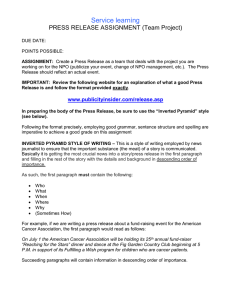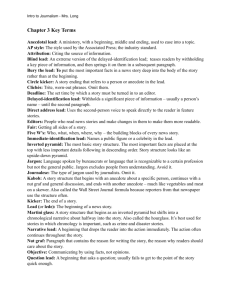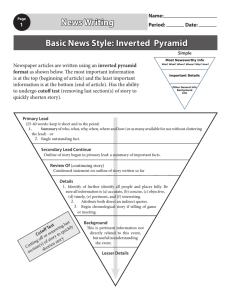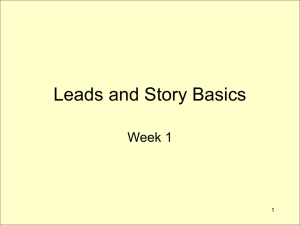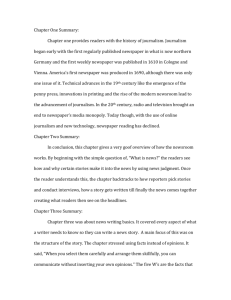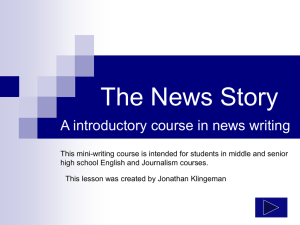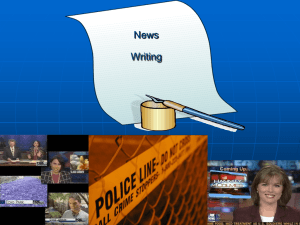Writing a News Story
advertisement
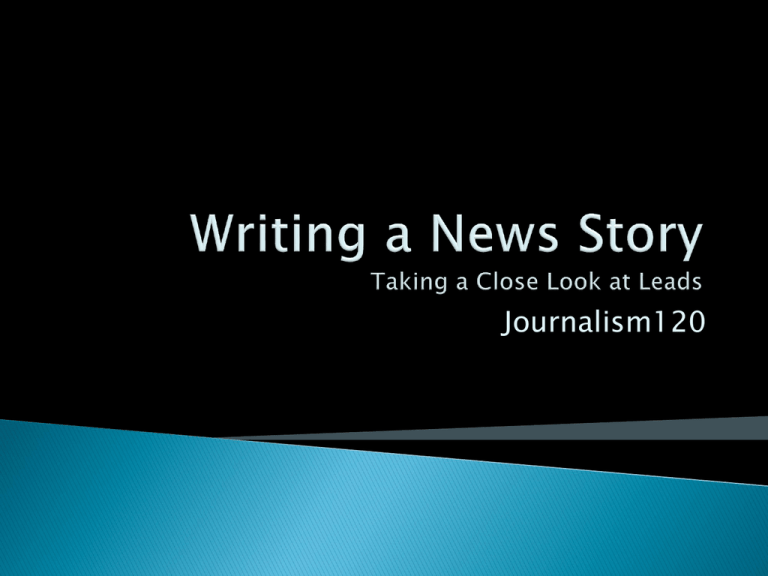
Journalism120 Michael Jordan, John Lennon, Malcolm X, Bugs Bunny? It seems that no one is immune from being a young man’s hero. Lights shine and sirens roar. It’s midnight and the police are scanning the streets searching for youth out past curfew. Three students await their expulsion hearing in front of the Board of Trustees after violating school and district policies in the last two months. As the clock strikes midnight, a procrastinating student sits down to work on a compensation which is due tomorrow. Lead- the beginning of news story; conveys the main idea in a few words to several paragraphs. By reading the leads of several stories, readers quickly gain key information about a number of topics and get an overview of the day’s most important news events. Readers decide in the first seven to fourteen words whether or not to read a story. Direct News Lead… is the first paragraph or two of a hard news story. the direct news lead gives the most important facts, the 5 Ws and an H about the story. (This type of lead is used on Hard News story. ) Direct news leads are also called 5 Ws and an H Lead because they answer most or all of the main questions readers will ask. The answers to these questions, given in the first paragraph or two, make up the lead. Choir members mixed business and pleasure at a recent national contest in New Orleans April 14-18 where the choirs reached first place all around. 1. 2. 3. 4. 5. 6. Who? What? When? Where? Why? How? Positive feedback from last year’s “Choices for Youth” program has allowed Overland’s Human Relations Committee, Youth Advisory Board and IMPACT Team to bring back the program again the week of May 2-6. 1. 2. 3. 4. 5. 6. Who? What? When? Where? Why? How? Leads that tell who, what and why are popular because readers recognize prominent names, and they want to know what is happening and what is important to them. A good strategy is to use the values that make story news: timeliness, prominence, proximity, conflict, etc. Which value or values make this story news to the audience? Who will be reading the story? What will they be most interested in reading about? A summary lead is a direct news lead that begins with a paragraph summarizing the story; the second paragraph presents specific details, such as names, ages, dates and locations. The opening statements of the summary lead are similar to the preview of movies. Readers get an idea of what the story is about, but they can’t really tell how the story will evolve until they have more information. One teen died and three others were injured in an accident in Adams County over the weekend. Travis J. Vapp, 17, died at 12:20 a.m. Sunday when the car he was driving went off a dead end at the T-intersection of Highway 14 and the KICS Road. Three passengers, Tom B> Hanson, 17, Amy M. Hayes, 17, and Ryan M. Conroy, 16, were injured in the crash. Using the picture below, write a summary lead. Example Bodiless heads are not usually the mainstream definition of beautiful art, but for one TFHS class, they have become both a creative outlet and a teaching tool. Art teacher, Shelly Christensen’s Studio Art class has recently been learning about sculpture and the human body through the molding of heads and torsos. Indirect leads are leads that set a scene or begin a story before revealing the topic of the article. They may also be called: Delayed leads Feature leads Storytelling leads They are usually longer than direct leads and introduce soft news stories. They tell stories and create images and typically vary from one to six or seven short paragraphs although there is no fixed rule. The NUT GRAPH, the paragraph that tells exactly what the story is about, concludes the indirect lead. In a direct news lead the first paragraph is the nut graph. Read the following article and indicate the following: 1. 2. 3. 4. Why does the indirect lead work for this article? How is the interest level strengthened? How is the topic of this story hinted at? When is the topic of the story made clear (nut graph)? Ultimately, what determines the lead you will choose as a journalist? “The judgement the journalist has to make is which kind of lead will work best for most readers.” Inverted Pyramid and Story Telling Benefits: Organizes information from most to least important Readers can quickly extract information Editors can easily shorten article following the inverted pyramid if space is a factor. Story Teller pattern is an organizational pattern that invited the reader in with an indirect lead, goes on to give the pertinent facts and information, and ends with a clincher. LEAD CLINCHER fact fact Inverted Pyramid Story Telling fact For this activity you will work in groups of two. You will be given one fairy tale to rewrite as: ◦ hard news with a direct lead using an inverted pyramid OR ◦ soft news with an indirect lead using a story telling pattern. Be sure to include ALL pertinent information from the story so that reader is not left confused or with questions.
